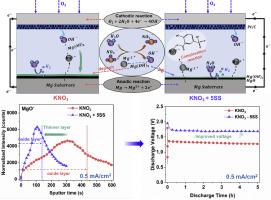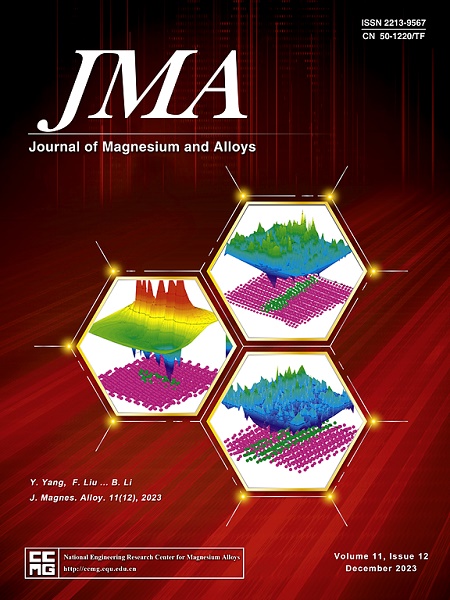Mg anode interface engineering in KNO3 electrolyte with sodium 5-sulfosalicylate as an additive for enhanced performance of Mg-air batteries
IF 15.8
1区 材料科学
Q1 METALLURGY & METALLURGICAL ENGINEERING
引用次数: 0
Abstract
The Mg-air batteries face limitations with pronounced hydrogen evolution and low anodic utilization efficiency from Mg anodes in conventional NaCl electrolytes. The corrosion performance, surface composition, and discharge properties of commercial purity Mg anodes were thoroughly investigated in KNO3 electrolytes with and without sodium 5-sulfosalicylate and compared to NaCl electrolyte. The addition of sodium 5-sulfosalicylate to KNO3-based electrolyte results in efficient inhibition of H2 evolution, consequently enhancing anodic utilization efficiency to 84 % and specific capacity to 1844 mAh/g, compared to NaCl (24 % and 534 mAh/g, respectively) under discharge condition of 10 mA/cm2 in half cell. Furthermore, the chelating ability of sodium 5-sulfosalicylate can significantly improve the Mg surface dissolution kinetics and discharge product deposition rate at the Mg anode / electrolyte interface, yielding formation of a thinner discharge layer as confirmed by time-of-flight secondary ion mass spectrometry. The discharge voltage is increased to 1.60 V, compared to 1.35 V in KNO3 at 0.5 mA/cm2 in full cell. However, higher concentration of sodium 5-sulfosalicylate can accelerate Mg anode dissolution, impeding the improvement of anodic utilization efficiency, specific capacity, and energy density. Hence, determining optimal additive concentration and current density is crucial for enhancing the discharge properties of Mg-air batteries and mitigating excessive Mg dissolution in chloride-free electrolytes.

以 5-磺酸钠作为添加剂在 KNO3 电解质中进行镁阳极界面工程,以提高镁-空气电池的性能
在传统的氯化钠电解质中,镁空气电池面临着镁阳极氢进化明显和阳极利用效率低的限制。我们深入研究了商业纯度镁阳极在含有或不含有 5-磺酸钠的 KNO3 电解质中的腐蚀性能、表面成分和放电特性,并与 NaCl 电解质进行了比较。在半电池 10 mA/cm2 的放电条件下,在 KNO3 电解质中添加 5-磺基水杨酸钠可有效抑制 H2 的演化,从而将阳极利用率提高到 84%,比容量提高到 1844 mAh/g,而 NaCl 电解质的阳极利用率和比容量分别为 24% 和 534 mAh/g。此外,5-磺基水杨酸钠的螯合能力可显著改善镁表面溶解动力学和镁阳极/电解质界面的放电产物沉积速率,从而形成更薄的放电层,这一点已通过飞行时间二次离子质谱法得到证实。在 0.5 mA/cm2 的全电池条件下,放电电压增至 1.60 V,而在 KNO3 中则为 1.35 V。然而,较高浓度的 5-磺基水杨酸钠会加速阳极镁的溶解,阻碍阳极利用效率、比容量和能量密度的提高。因此,确定最佳添加剂浓度和电流密度对于提高镁空气电池的放电性能和减少无氯化物电解质中镁的过度溶解至关重要。
本文章由计算机程序翻译,如有差异,请以英文原文为准。
求助全文
约1分钟内获得全文
求助全文
来源期刊

Journal of Magnesium and Alloys
Engineering-Mechanics of Materials
CiteScore
20.20
自引率
14.80%
发文量
52
审稿时长
59 days
期刊介绍:
The Journal of Magnesium and Alloys serves as a global platform for both theoretical and experimental studies in magnesium science and engineering. It welcomes submissions investigating various scientific and engineering factors impacting the metallurgy, processing, microstructure, properties, and applications of magnesium and alloys. The journal covers all aspects of magnesium and alloy research, including raw materials, alloy casting, extrusion and deformation, corrosion and surface treatment, joining and machining, simulation and modeling, microstructure evolution and mechanical properties, new alloy development, magnesium-based composites, bio-materials and energy materials, applications, and recycling.
 求助内容:
求助内容: 应助结果提醒方式:
应助结果提醒方式:


